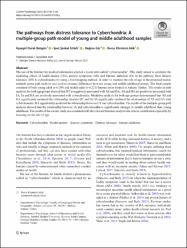The pathways from distress tolerance to cyberchondria: A multiple-group path model of young and middle adulthood samples
Künye
Durak Batıgün, A., Şenkal Ertürk, İ., Gör, N. ve Kömürcü Akik, B. (2021). The pathways from distress tolerance to cyberchondria: A multiple-group path model of young and middle adulthood samples. Current Psychology, 40(11), 5718-5726. https://doi.org/10.1007/s12144-020-01038-yÖzet
The use of the Internet for medical information elicited a recent term called "cyberchondria". This study aimed to scrutinize the mediating effects of health anxiety (HA), anxiety symptoms (AS), and Internet addiction (IA) in the pathway from distress tolerance (DT) to cyberchondria by using a bootstrapping method. In order to examine the role of age in the proposed model, multiple-group path analysis was used to evaluate differences between young and middle adulthood groups. The final sample consisted of both young adult (n = 209) and middle adult (n = 221) Internet users located in Ankara, Turkey. The results of path analyses for both age groups showed that DT is negatively associated with AS and HA; AS and HA are positively associated with IA; IA and HA are positively associated with cyberchondria. Mediation analysis for both age groups demonstrated that AS and HA significantly mediated the relationship between DT and IA; IA significantly mediated the relationships of AS and HA with cyberchondria; HA significantly mediated the relationship between DT and cyberchondria. The results of the multiple-group path analysis showed that the relationship between IA and cyberchondria is significantly stronger in middle adulthood than young adulthood. The results of the current study are consistent with the relevant literature and provide crucial contribution especially by focusing on the role of age.


















